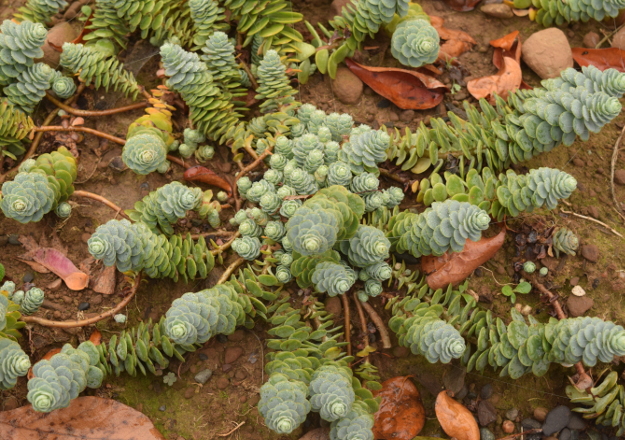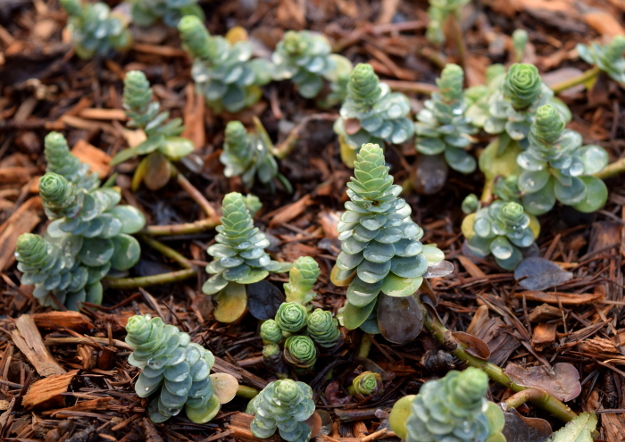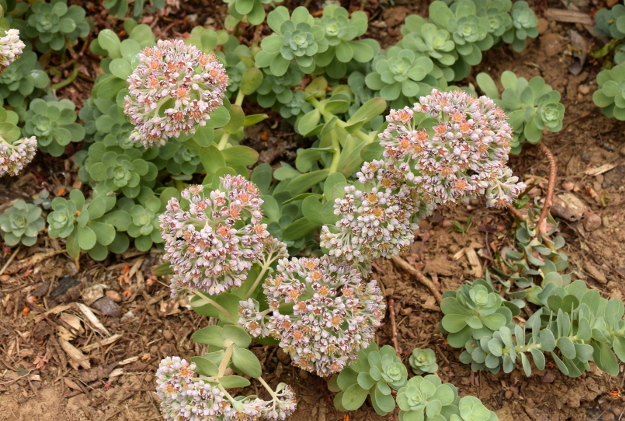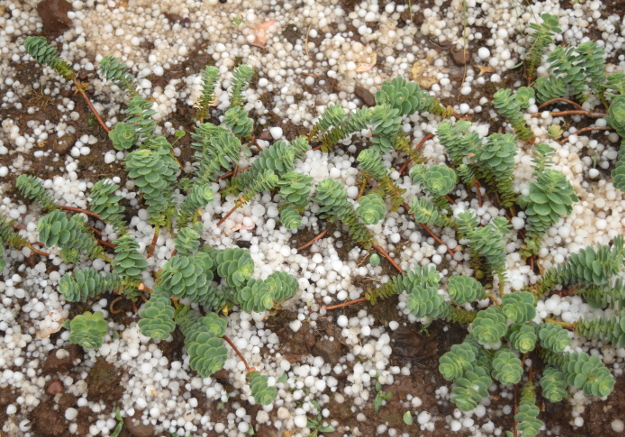Baby come back, you can blame it all on me
I was wrong, and I just can’t live without you…

I would not like to live without Sedum anacampseros (a.k.a. Hylotelephium anacampseros) in my garden, which goes by the intriguing common name of “love restorer” or “lover-come-back.” The French call it orpin (sedum) des infidèles. This humble little plant supposedly has the ability to restore lost love, though I like it simply because it’s so incredibly charming.
The plant catches everybody’s eye when they visit my garden. It has a beautiful geometry to it. The stems radiate from the center, with smooth, succulent, blue-green leaves spiraling around them. The leaves get smaller towards the ends of the stems, like the scales on a pangolin’s tail.
Love restorer makes a tidy circle of foliage only a few inches tall and one foot wide, although sometimes a stem will root in the ground and start a new circle. In this way, it gradually covers more ground, but it is never aggressive.

In winter, Sedum anacampseros has a semi-evergreen presence. Inner leaves will often drop, leaving whorls of overlapping foliage at the tips of the stems. Here it is on Christmas Day a few years ago in my zone 8 Portland garden.
Like virtually all sedums, it releafs early in the spring.

If it does start to look leggy, resist the urge to prune too much, because the flowers emerge from buds set the previous year. Blooms tend to be sparsely produced, but they’re a treat when you get them. Unlike other sedum flowers, which are nearly always white, pink, or yellow, this species’ blossoms sport odd dusky lilac petals, surrounding yellow-orange carpels (where the seeds form). The coloration is subtle, but thoroughly delightful. They open in July in my garden.
Native to the mountains of Spain, France, and Italy, love restorer enjoys typical alpine conditions. This means bright light, sharp drainage, cool nights, and occasional water. It also prefers acidic soil. Don’t think of it as a fussy rock garden plant, though—it’s quite easy to grow. It can handle some shade, and its leaves will be larger and lusher there but not so closely spaced. It’s cold-hardy to zone 3 (-40°F).

This past June, Sedum anacampseros survived the worst hail storm I’ve ever experienced. The foliage wasn’t damaged at all, though a lot of my other plants looked like they’d lost a fight.
The only problem you may encounter with this plant is an occasional aphid attack, but even that is rarely serious. Predatory bugs and birds will normally swoop in and restore the balance when such outbreaks occur. You can knock the aphids down with a jet of water from the hose if you like, giving ground-dwelling beetles a chance to do their part.
Sedum anacampseros is not very available in the trade, but that’s changing, at least in the Pacific Northwest. A couple of years ago, I gave a bunch of cuttings to my friend Mark Leichty at Little Prince Nursery. Little Prince is a wholesale supplier to garden centers around the region, and lo and behold, last year I started to see my plant popping up at nurseries. I can’t tell you how gratifying it is to see a special plant from your own garden become available to other gardeners! If you’re growing something unique that you think ought to be shared, I urge you to give it to a nursery owner. It feels wonderful to see it in circulation!


I have a bunch of sedums (maybe 6 or 7 of them) planted inside a concrete hedge situated at the ground level; this way they do not disperse beyond control and consequently require cutting. They do impart a vaguely exotic flair to the garden. Very easy to maintain in this setup.
This one would be a good addition to that group! It’s great in a container.
Looks like a winner to me! A couple of your photos have a slight Orostachys iwarenge look to them, a plant I wish I could grow, but cannot.
I have never seen Orostachys for sale, but I would like to try it.
It was instant love when I saw this sweetie for sale at Little Prince last year during the Garden Blogger’s open. Mark quickly attributed it to you. My plant is in a container and doing great. Fyi, I found Orostachys boehmeri at Bauman’s in Woodburn. It does great in a pot but looks like death in the winter. In fact it’s blooming right now.
Oh, I’m glad you snagged one! I haven’t been to Bauman’s, I’ll have to check it out sometime.
anacampseros is oddly similiar to your name. i will look for this plant next visit to LP. it is adorable and would be happy with other plants i enjoy in my garden that came from you. this plant also reminds me of a much much better Euphorbia myrsinites.
It is much smaller than Euphorbia myrsinites but has that same kind of geometric appeal.
I dare anyone to read this post without putting this charmer on their wish list (near the top).
It’s a cutie!
535513 758Thank you for your style connected with motive though this info is certain location a new damper within the sale with tinfoil hats. 216055